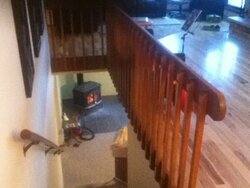"Lil too much house for the stove" was meant to imply too much sq footage to heat with the stove during real cold weather, not too much insulation. Sorry, bad choice of words to describe. When pushing the stove load it around 10pm then again around 3am and then burn down coals when I get up at 7 so I can get temps back up on the stove. Upstairs has dropped to 58 at the lowest when doing this. So my thought is instead of waking up in the middle of the night to reload I could just start up a fire in the upstairs and hopefully use the same amount of wood.How do u mean the house is insulated a lil too much? What are the symptoms of that? Also, how long between reloads during those cold snaps, etc.?
Pushing a stove hard during cold weather justify a second stove?
- Thread starter swagler85
- Start date
-
Active since 1995, Hearth.com is THE place on the internet for free information and advice about wood stoves, pellet stoves and other energy saving equipment.
We strive to provide opinions, articles, discussions and history related to Hearth Products and in a more general sense, energy issues.
We promote the EFFICIENT, RESPONSIBLE, CLEAN and SAFE use of all fuels, whether renewable or fossil.




